The world of film loves mining halls of folklore and legend for stories, and one of those oft-traveled halls belongs to King Arthur and his Knights of the Round Table. But which Arthurian movies are the best? Which are emphatically the worst? How do we make those judgements and why? These are not the questions that plague our era, but they sure do bug us from time to time, and so we have decided to rank the lot.
We should mention that it is fairly impossible to include every Arthurian movie on account of there being so many, and the fact that plenty of them are relatively inaccessible. So we have assembled a basic master list that includes films that are easy to find and watch. We have ranked them worst to best and included some helpful criteria to that end.
Ranking Criteria: We have decided to rank each movie according to three basic standards because life is more fun that way.
- Grails—How the story chooses to tackle (or ignore) Holy Grail questing and legend within the plot.
- Round Tables—How the story handles politics and romance.
- Excaliburs—How the story deals with action and magic.
And here is our very careful, very thorough ranking! The most thorough. The thorough-est.
10. Prince Valiant (1997)
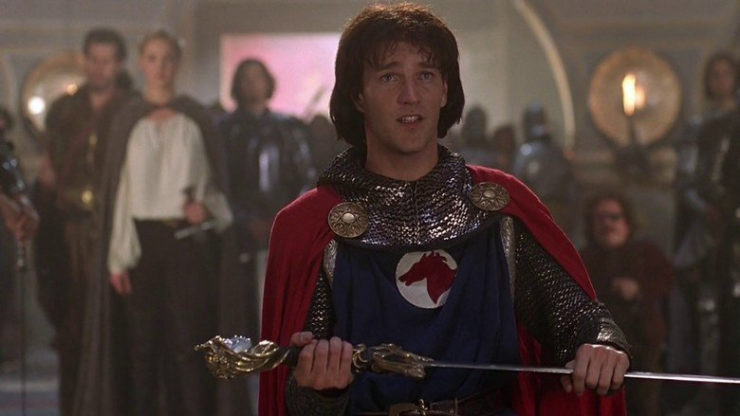
Loosely adapted from the humorous comic book strip of the same name, Prince Valiant is about the side characters in Arthurian legend. Squire Valiant, masquerading as Sir Gawain, must retrieve King Arthur’s sword Excalibur from Vikings led by an exiled Morgan le Fay.
Grails: No Grail quest here, everyone’s too busy journeying to Thule (a.k.a. Scandinavia) to do battle with evil Vikings.
Round Tables: The filmmakers really force the love story between Valiant and Princess Ilene, which is entertaining only to watch Stephen “Vampire Bill” Moyer and Katherine “Izzy Stevens” Heigl act out the rules of chivalry. Though Valiant (pretending to be Gawain) goes on about knights not being allowed to feel anything, and Ilene is engaged, their misadventures nonetheless bring them together. Yet the only interesting moment is when Ilene gives Valiant her ring to bring to her princely fiancé, ostensibly to prove that she is alive—only for her fiancé to reveal that Ilene said she would remove the ring only if her heart no longer belonged to him.
Excaliburs: Even though the plot revolves around Excalibur falling into the wrong hands, the logic doesn’t quite track. In a rehash of the original legend, the sword embeds itself in the stone floor of the Vikings’ throne room, to be pulled out by only the most worthy. Yet the person who is able to wield it is not Sligon, the Viking who stole it, but his unstable and psychotic brother Thagnar. It would appear that Morgan’s plan was less about handing Excalibur to someone new than to simply taking it away from her brother Arthur. Back in Camelot, the king is bereft without his sword (which he feels has “abandoned” him) and is all but ready to hand over control of his kingdom to anyone else. If that’s all it took to destroy the dream of Camelot, then maybe Morgan should have been allowed to succeed. —Natalie
9. Merlin and the Sword AKA Arthur the King (1985)

Modern-day Camelot enthusiast Dyan Cannon travels to Stonehenge, breaks away from her tour group, and falls into a shadowy netherworld, where she meets Merlin and Niniane. They create a mystical slideshow of their lives at Camelot, and watch as Arthur, Lancelot, and Guinevere are all undone by lust/Mordred/Morgana le Fay/destiny. This one inspires so many questions! Why is there a Limbo universe underneath Stonehenge? Why is Dyan Cannon fondling Stonehenge and murmuring sweet nothings to Merlin? How the hell could Malcolm McDowell make a boring Arthur? What on earth was Candice Bergen thinking? Couldn’t they have found a better dragon puppet?
Grails: The Grail becomes important in the last two minutes of the film, when an Astral Projection of Merlin tells Lancelot to ditch Guinevere and go on a Holy Quest to atone for his repeated adultery.
Round Tables: Lancelot and Guinevere fall in love at first sight…but only after Arthur refuses to allow her to be co-ruler, and also sends Lancelot to rescue her from Evil Pict Liam Neeson rather than doing it himself. Guinevere initiates the affair, which, according to Lancelot, brings about the fall of Camelot. This despite the fact that Morgana’s been plotting against Camelot the whole time, and, oh yeah, Mordred stabs Arthur to death with Excalibur. Yeah. Totally Guine’s fault. Also: this film includes the tale of Gawain and Dame Ragnelle, who is enchanted to look like a pig until Gawain’s love and respect for her breaks the curse.
Excaliburs: As far as knightly action goes, I have attended Renaissance Festival Living Chess Games that were better staged and fought than the action in this film. Arthur already has Excalibur, but doesn’t make a big deal about it. Later, Lancelot is able to wield Excalibur to defeat the dragon puppet Morgana unleashes through her magic. While Merlin and Niniane are both powerful magicians, Morgana is able to condemn them to HengeLimbo. Merlin and Niniane are trapped beneath Stonehenge for a thousand years until Dyan Cannon suggests they might be able to escape through the power of LOVE. When this works, they fly back to Camelot, ignoring Dyan Cannon’s desperate pleas for them to take her with them. —Leah
8. King Arthur: Legend of the Sword (2017)
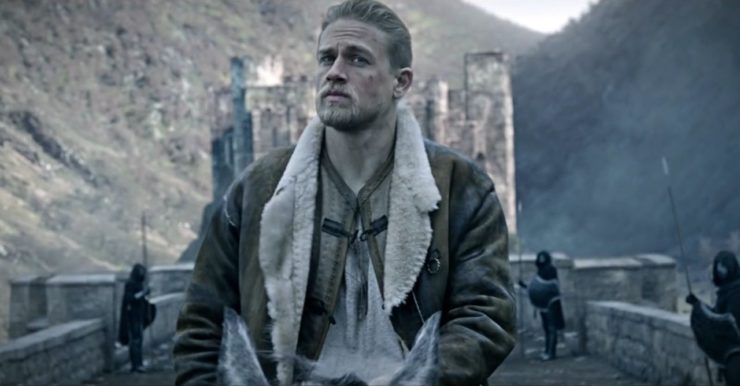
This charged action-fest from Guy Ritchie is the latest attempt to put Camelot on the big screen, bringing Arthur of the street (Charlie Hunnam) into the fold after being orphaned due to family trauma. His magical sword Excalibur grants him superpowers to defeat his evil uncle, Jude Law. And in case any of this imagery is too metaphorical: Jude Law is building an enormous tower. As he grows more powerful, the tower grow ever higher. And the only thing that can cause the tower to collapse is (A) Arthur’s mighty sword and (B) an enormous snake.
Grails: No interest in Grails this time around…these lads are probably scared they’ll get cooties from anything as feminine as a Grail. Lots of magic instead. Lots.
Round Tables: Not much romance here. In fact, pretty much the opposite of romance, even if Arthur clearly has a crush on his mage pal. The politics are all family oriented, with Jude Law causing tyrant problems and killing people to gain fancy magical powers. There’s a resistance within the kingdom against his rule, but they’re so much canon fodder as far as the story is concerned. And the knights have a very Merry-Men-in-Sherwood-Forest vibe.
Excaliburs: It’s a Guy Ritchie film. Action is the sole reason for its existence. Unfortunately a huge portion of that action is devoted to abusing and murdering the majority of the female characters present in the film. Oh, and Arthur runs a brothel? But it’s okay because he makes certain that the women working there don’t get beat up too bad! He’s kind of a mobster who extorts money from his fellow city-dwellers, and he calls men who annoy him “honeytits,” which is definitely an attribute the world has been waiting to see in the king of Albion. He runs Camelot like a frat house by the end, where the pledges are what count because he’d “rather have friends than enemies.” Round Table all the way, bro. Oh, and in case you were wondering? Excalibur is so huge, you need two hands to wield it. And once you use two hands? Your dead dad might just tell you the magic was inside you all along. There is a lot of magic, of course, most of it bound up in tropes from other fantasy narratives that the world knows quite well, from Lord of the Rings to Narnia. It’s eighteen kinds of wrong, but it clearly doesn’t want to be right. —Emily and Leah
7. First Knight (1995)
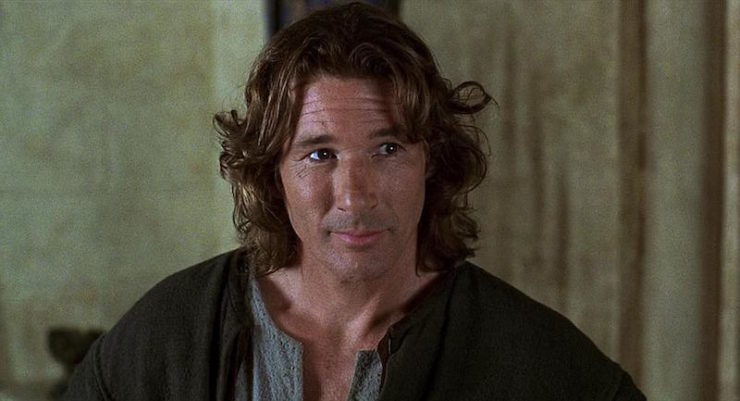
Look, envisioning Lancelot as a sort of vaguely Han Solo-ish lone wolf with a squinty charm isn’t the worst idea… provided you cast someone with the charisma to pull it off. That person is not Richard Gere. It is especially not a Richard Gere who can’t be bothered to even try a British accent. Set in Arthur’s later years, First Knight tries to smash together love triangle nonsense with a story about a scowling dude who wants to be king, with middling-at-best results. (Jerry Goldsmith’s swoopingly overwrought score does its very best to build a sense of grand romance, but is fighting a losing battle.)
Grails: What grail? This story has very little interest in mythology. Mostly it just borrows the names from Arthurian stories.
Round Tables: Guinevere (Julia Ormond) agrees to marry Arthur (Sean Connery, 35 years older than Julia Ormond) largely in order to protect her home. On the way to Camelot, she meets Lancelot (Gere, 16 years older than Julia Ormond), who is immediately far more into her than she is into him. Politically speaking, there’s a nasty former knight named Malagant roaming about setting fire to villages; he wants to be king, of course. None of the romance is very convincing, particularly given that upon their first meeting, Lancelot pretends he wants to rape Guinevere (as a tactic to get her away from a kidnapper) and later insists he knows when a woman wants him. Go away, Lancelot. Lance-not. Also everyone in Camelot wears blue, which, in this era of color-coded dystopias, is rather disconcerting.
Excaliburs: There is nothing magical about this movie. However, there’s one briefly gorgeous action sequence when Arthur sets a trap for Malagant and his forces. As Malagant burns an empty encampment, Arthur and his knights ride out from the woods. It’s dark, but the light from the fires glints off all their shiny armor (the horses even have mane armor! Which makes sense, if you think about it). It’s the most enthralling moment in the film… until mere moments later, when the night scene is inexplicably bright. Lancelot also has a nifty swordfighting scene or two—nothing flashy, just a touch of deft choreography. —Molly
6. King Arthur (2004)
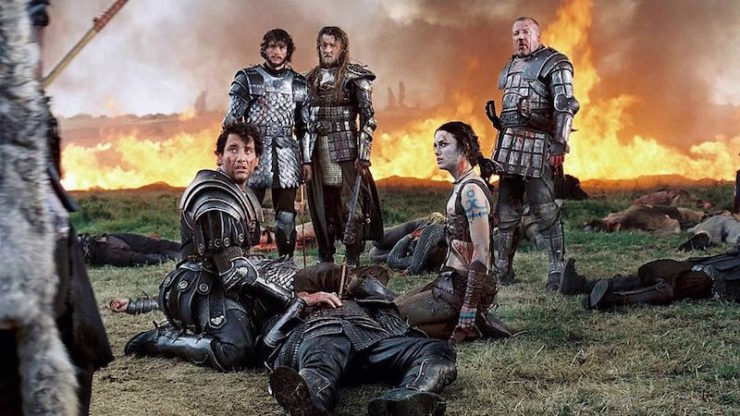
A gritty attempt to update Arthurian legend by adding a dose of realism (i.e. what if Arthur had actually been a real person, what would that look like?) The realism is somewhat sidelined by Keira Knightly’s Guinevere appearing in a leather-braided tube top.
Grails: Grails do not exist in gritty real-world legends. How dare you suggest such a thing.
Round Tables: There is some romance. Arthur (Clive Owen) and Guinevere like each other a whole lot, and he frees her pagan Celtic person from Catholic immurement, which is awfully nice. They get married at the end of the movie. There is a faint suggestion that maybe Guinevere and Lancelot (Ioan Gruffudd) could like each other, but the film leaves off the whole love triangle plot. We have Mads Mikkelsen as Tristan, but there is no Isolde because real-world legends only have room for one romance, dammit. (Or you could just decide that this is a proto-Hannibal/Will Graham situation, since Hugh Dancy is ably playing Galahad.) The politics are all there because in this version Arthur is a Roman who is fighting at the end of Rome’s occupation of Britain. He and his knights have served their fifteen years in the Roman army and are expecting to be relieved when they are given one last big mission to travel north of Hadrian’s Wall and grab a few people who are very important to Rome. This eventually leads Arthur to make friends with the Woads so that they can beat back the Saxon threat, and a bunch of his knights die in the process.
Excaliburs: There’s no magic in the story, obviously. All of the faux-historical leanings in this retelling are there to prop up a metric ton of action. Guinevere herself has been restyled to better resemble Queen Medb or Boudica more than the Guinevere of Arthurian legend. Despite its desire to bill as a more “realistic” version of what Arthur might have been, it is such a hodgepodge of resources that it morphs into its own brand of fiction, failing to resemble historical accuracy in the slightest. Sure, there were Romans and Saxons and Celts who fought each other in Britain at one point, but that’s about all the care that was taken. Which is a shame, because a carefully conceived “historical Arthur” could make for a very interesting story… it’s just not one the filmmaker’s want to tell. —Emily
5. Sword of the Valiant (1984)
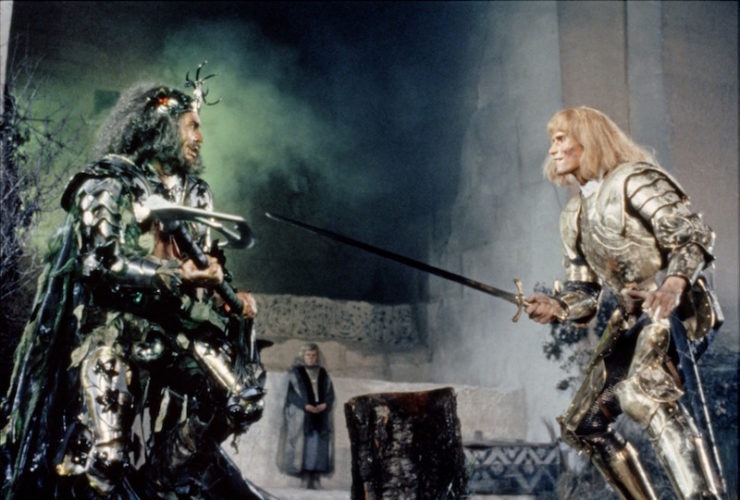
The second attempt by writer/director Stephen Weeks to adapt Sir Gawain and the Green Knight into a film—the first was released in 1973, but this second version found a (slightly) larger audience. Gawain himself is played by Miles O’Keefe, of Tarzan, the Ape Man fame; the director had hoped to cast Mark Hamill in the role, but the producers were not overfond of the idea. The film also features Peter Cushing, John Rhys-Davies, and Sean Connery as the Green Knight.
Grails: Not much to be said about the Grail in this one. There’s a lot of questing, but none that pertain to religious artifacts of any kind.
Round Tables: Politics is thin on the ground in this particularly story, although it does begin with Arthur scolding his knights for getting too comfortable and not being more active in their knight-ness. There is a fair bit of romance, though; Gawain falls for a mysterious lady, who keeps gifting him magical stuff that keeps him out of trouble—a ring that transports him, a cloth that prevents the Green Knight from being able to cut off his head. This poor woman is kidnapped and carried off and then liberated by a Baron, and it’s all very complicated.
Excaliburs: So much action and magic. Every action and magic. The whole story starts because of the Green Knight (can we talk about the fact that the world is convinced that Sean Connery belongs in Arthurian legend? maybe he’s the real Merlin) challenging Arthur’s court to a game that turns out to be rigged; he gives young Gawain one chance to behead him, then gets one chance in return. Trick is, he can reattach his head, and Gawain obviously cannot. He gives the kid a year to solve a weird riddle in lieu of death, so Gawain’s whole journey is supposed to be about figuring out that riddle. Instead he ends up fighting lots of people and getting magicked around. He does defeat the Green Knight in the end, with a little help from his fancy magical lady friend, who gives him that unbreakable kerchief to protect his head. But she has secrets of her own, and ends her role in the story by turning into a dove and flying back to Lyonesse. Tough break, Gawain. —Emily
4. The Sword in the Stone (1963)
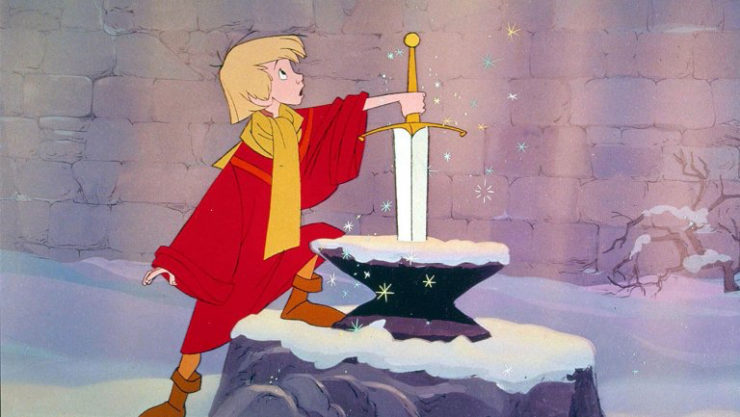
In Disney’s animated take on T.H. White’s The Once and Future King, absentminded wizard Merlin takes orphan Wart (a.k.a. Arthur) under his wing and teaches him how to be a good king by transfiguring him into a bunch of animals, all in preparation for Arthur eventually retrieving Excalibur.
Grails: Seeing as this focuses just on Arthur’s boyhood, there’s absolutely no talk of grails, holy or otherwise. In fact, the only significant vessel is an animated sugar cup.
Round Tables: Arthur’s still an orphan, but his true lineage doesn’t play into the story at all; no Pendragons to be found here. Nor does Guinevere come into play, though there is a messed-up scene in which Wart, transfigured by Merlin into a squirrel, attracts the attention of a flirty lady squirrel. Despite his attempts to explain that he’s a human, it’s not until he’s transformed back that she gets it—and she recoils, chittering in horror and sadness. Because lady squirrels mate for life, and now she has no mate, and why exactly was this cruel interlude necessary to the story?
Excaliburs: While there’s a promising moment with Wart assembling a dummy horse and jouster for Kay to practice with that shows the boy’s ingenuity, we never see him get to apply his dream craftings to anything real. He doesn’t even live vicariously through Kay, as he’s demoted from his brother’s squire after Merlin interferes with Wart’s chores. But in terms of literal Excaliburs, the movie gets there in the last 20 minutes of the movie (taking its sweet time ::grumble::), when Wart realizes with horror that he’s left Kay’s sword at the inn. With the building closed, he reaches for the closest substitute: the mysterious sword in the stone in the middle of the town square. Down comes the radiant light and Disney-esque “ahh”ing, and next thing we know, Wart is King Arthur. —Natalie
3. Excalibur (1981)
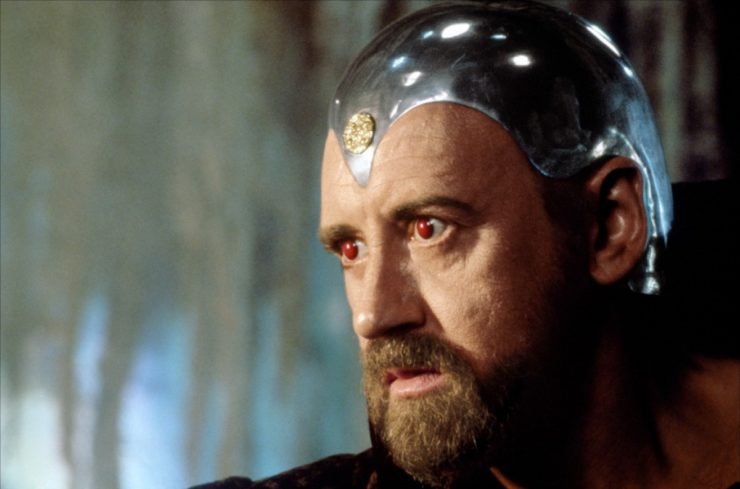
I saw Excalibur for the first time a few years ago, at the Met, which might be the best way to watch it, as it is very long and at times slow, and the distractions of the modern era are many. That said, it’s also very Arthurian, and is long enough to include even Uther (Gabriel Byrne? Really?), who becomes king and then makes a very stupid decision: He absolutely must sleep with the Duke’s wife, Igrayne, who dances like a glorious ren faire maiden of ye olde 1970s. Arthur is begotten, and the story goes from there, following familiar ground involving Guinevere, Merlin, Morgana (a mashup of Morgan le Fay and Morgause, played by a stunning young Helen Mirren), Lancelot and the rest. This is all the good stuff; the less good stuff is that much if not all of the dialogue appears to be looped, which gives everything a stilted, distant feeling that director John Boorman probably meant to be mythic. It is about as magical as Merlin’s silver bald cap.
Grails: Yes! We’ve got a grail quest! Excalibur twists the Fisher/Wounded King up with Arthur, who is the land and the land is him. After the affair of Lancelot and Guinevere, Arthur makes a very bad choice involving his half sister; he and the land suffer, and the Grail quest begins. The eerie things Percival encounters on his quest are some of the movie’s most memorable images, including a spooky young Mordred in golden armor.
Round Tables: From Uther’s opening bad idea to Arthur’s connection to the land, Excalibur foregrounds a mythical sort of politics that makes each individual’s choices resonate on a larger scale. Arthur doesn’t know who he is until he pulls Excalibur from the stone, and there’s a suggestion that perhaps his ordinary upbringing will make him a better ruler than his father (Merlin set this scenario up, after all, and wizards always think they know best). But all the characters are driven by their desires in believable ways, from horny Uther to Morgana (who keeps herself young, the better to ensorcel knights) to guilt-stricken Lancelot to Gawain (Liam Neeson, looking like a red-faced, bearded baby) who is prodded into stirring the political pot. Though the romance is less convincing, Arthur’s heartbreak over Lancelot and Guinevere rings true—it has as much to do with brotherly love for Lancelot as it does his marriage.
Excaliburs: Excalibur is here for your battle needs: Castle-storming! Mace-waving! Jousting! And blond-haired sparkle-armored Lancelot on a white horse! Magically speaking, the sword Excalibur glimmers with green light; the lady of the lake makes a few appearances; Merlin gets caught in crystal; the land blossoms the moment Arthur drinks from the grail. And there’s what I can only describe as a puny fake Stonehenge! It is possible to kind of conceptually love a movie yet never want to watch it again? —Molly
2. Monty Python and the Holy Grail (1975)

I’m assuming I don’t have to sum this sucker up for anyone on this site. As with all Python, the extra fun aspect is going back as an adult and discovering that there’s a well-made, meticulously researched movie under all the silliness.
Grails: The Grail Quest is granted to Arthur by God Himself! Pretty snazzy. The Quest includes Galahad’s stop at a castle full of temptresses, angry French people who don’t want the Brits stealing their Grail mythos, and even the detail from Malory’s Mort D’Arthur that Sir Bedevere is the Last Knight Standing during Arthur’s final siege.
Round Tables: Arthur and his Knights refer to Camelot as their home base, but they also decide not to go because (as Richard Harris would no doubt attest) “it is a silly place.” We never see a Guinevere, and its worth noting that in Spamalot Lancelot ends up with Prince Herbert.
Excaliburs: Arthur wields supreme executive power because some watery tart threw this sword at him. The knightly action is surprisingly good—the battle with the Black Knight is of course especially memorable. There is no Merlin, no Mordred, nor Morgana, but we do get TIM THE ENCHANTER, who seems like a powerful magical presence. —Leah
1. Camelot (1967)
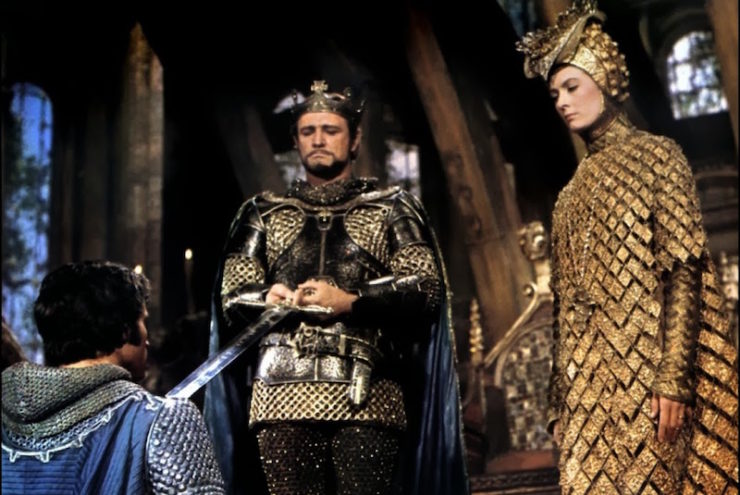
The film version of the beloved Lerner and Loewe musical, adapted largely from a piece of T.H. White’s The Once and Future King. Responsible for every 60s lounge singer recording their own rendition of “If Ever I Would Leave You.”
Grails: No one cares about grails here at all. Like if they could negative care, I’m pretty sure they would.
Round Tables: This story largely revolves around romance and political maneuvering. Guenevere (Vanessa Redgrave) loves Arthur (Richard Harris can sing!??), but she also loves Lancelot (Franco Nero), and Lancelot loves Guenevere and cares deeply for Arthur, and Arthur adores them both, and no one wants to hurt anyone, and everyone hurts each other. The result is that Arthur almost has to burn his wife at the stake (he’s been advocating rule of law for his Camelot to function, and that is the law for adultery… which seems like maybe a bad law to have in your very fair and noble kingdom of equality), and then has to battle his dear friend and destroy his kingdom. Guenevere feels bad for causing so much trouble and becomes a nun. All of this is the result of political machinations on the part of Mordred, who’s mad that Arthur won’t recognize his legitimacy as a son. If you’re into the fated romantic aspect of Arthurian legends and the idealism of the Round Table, this is where it’s at. If you love musicals, it’s even better.
Excaliburs: There is very little magic here, though Merlyn does make an appearance when Arthur calls on him for advice at the opening. The action of the story is largely a framing device; the musical starts and ends with Arthur on the battlefield, about to fight against Lancelot and his cohort. But there is also jousting! Guenevere gets Lancelot to joust three other knights because she doesn’t much like him at the start. It’s pretty great. Also, you can’t really get a better show of ego than Lancelot’s opening number, “C’est Moi.”
Out of all the options we have in this list, Camelot has many of the hallmarks that people love about Arthurian legend—the Round Table, the political upheaval, the ideology of Camelot, the love triangle. It is also lifted from one of the most popular retellings of the story. All of these aspects, combined with some truly sumptuous design, give it the top spot. —Emily
* * *
So… the greatest versions of Arthurian legend on film are a musical and a comedy. Which brings us to one very important conclusion:
No one has made the great Arthur film this world deserves. Yeesh.
Originally published May 2017.










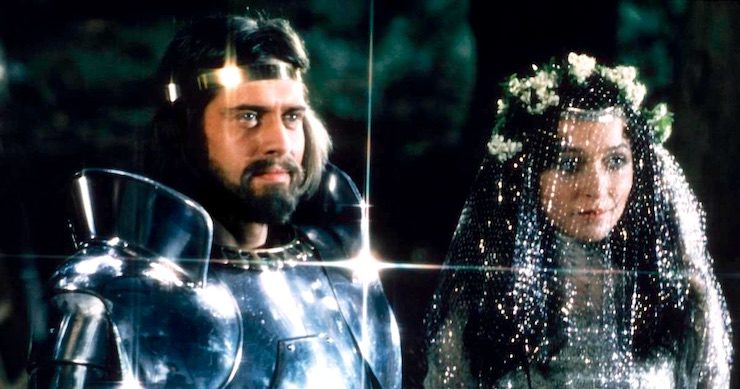
Yeah, I know it was “just TV,” but Bradley James in Merlin was an excellent Arthur, and is definitely worth a mention.
So, I’m mentioning him.
…not to mention the creative retelling with Arthur and Merlin around the same age.
There was another Prince Valiant movie, and I’m surprised Knights of the Round Table didn’t make the list.
#7. Why should Lancelot have a British accent? He’s French.
@@.-@.rragnarredbeard. That’s even worse, can you imagine Gere trying to do a French accent.
Also, yay for Camelot!! It’s a guilty pleasure of mine. The music, Richard Harris so young you almost don’t recognize him (my daughter refused to believe that was Dumbledore for years!), Vanessa Redgrave in those gorgeous furs (and I don’t even like fur).
Some hilarious quotes there. The only thing I’d change is sliding my absolute favorite down to #1, but then, my isn’t Arthur-centric. It’s Merlin-centric and it’s especially magic-filled and fairyesque.
I’m talking about 1998’s made-for-TV 1998’s Merlin with Sam Neill. The Arthur legend has been visited and twisted up so many times and I have so little invested in the mythos that this version’s meddling doesn’t bother me at all. Great cast, a mix of stellar and silly acting, but overall an excellent romance. The only disappointment is how feeble Rutger Hauer (of Ladyhawke!) is in this one. Man, I need to go watch this one again!
How could you mention “Excaliber” without mentioning Guine’s dad was Patrick Stewart?!? It was also a family affair for Director John Boorman. His son Charley played Mordred as a boy, and his daughter Katherine played Ygrayne, she who Gabriel Byrne-d for.
The actor (the late Robert Addie) who played Mordred grown up in “Excaliber” went on to play Sir Guy of Guisborne in the TV serial “Robin of Sherwood” — He was one of the better baddies, and since he grew up playing polo, had probably the best horse riding chops of anybody in either production.
Does anyone else remember the mini series “Merlin,” with Sam Neill as Merlin, from 1998? I feel like I’m the only person who remembers it. I had to look it up on IMDb to make sure I was remembering right. Didn’t even know that Helena Bonham Carter was in it, I wouldn’t have recognized her back in 98 when it aired.
@6 Yes! I knew I couldn’t be the only person who’d seen that one! Wish I’d seen your comment before I posted mine.
I like the circa 1984 video recording of Richard Harris in a stage production of Camelot better than the actual movie of it. And I would love to play Arthur in that show someday, if only for that beautiful final scene with young Tom of Warwick: “And because of the stories people tell, you wish to become a knight?”
@6 I remember that version! It was really good and have great special effects but I’ve never met anyone who watched it too because it was broadcast on cable once or twice!
Another TV adaptation which did a pretty good job of trying to be ‘historically accurate’ : Arthur of the Britons starring Oliver Tobias as Arthur. Not even a smidge of magic.
The BBC also adapted the first of Mary Stewart’s Merlin books : http://www.imdb.com/title/tt0289739/
@10, me too! I like the way the songs are performed and the singers much better in the stage video than the movie.
And then there’s Arthur of the Britons, an early-70’s UK TV children’s series with Oliver Tobias as a historically accurate Arthur and BRIAN BLESSED as King Mark. It’s surprisingly good fun even if the battle scenes seem to have armies of about 15 a side.
And as for Excalibur, a mad film that is one of my guilty pleasures but still the closest to Malory’s Morte d’Arthur that I’m aware of.
@12
Got in there before me:)
@6 and others… Re: Merlin TV show
Wow. Tell me the Harry Potter movie people hadn’t seen Helena Bonham Carter in this before they cast and did makeup on Bellatrix LeStrange.
16. nancymcc
That’s what Helena Bonham Carter looks like in real life, except perhaps not quite as pale.
@11, I’ve proudly owned it on VHS for years. :)
I really like Martin Short’s character in it—which I think is an altogether new character—Frik.
@18 I think I remember Frik, he was the one who turn around and changed faces, similar to Jaqen from Game of Thrones only that the it was a continous moment? I remember that, Helena Bonham Carter and that the Lady of the Lake was awesome.
Michael Livingstone should totally review Arthurian films for Medieval Matters! (hint at Tor)
Was anybody else obsessed with the animated “Quest for Camelot” back in 1998? It had the best songs…
And #11, Last Legion with Mr. Darcy -er Colin Firth? A curious Roman take on the legend.
@20 I remember that one! I watched it again recently for the first time in many many years. The songs held up, but unfortunately nothing else about it did :/
I’m not very invested in the Arthurian mythos, but the Pythons can do no wrong and I had a tape of Disney’s Sword in the Stone growing up so I’ve got a soft spot for it. I love the grumpy owl, Archimedes, and I love the insolent sugar bowl. Is it a good movie, or an accurate one? Nope. But it’s fun, and I’d rather have fun than accuracy, personally.
I’d strongly recommend Sebastian Baczkiewicz’s radio series, Arthur. It also has an amazing cast: Ben Wishaw as the young Arthur, Ian McDermid as Merlin, Eve Best as Morgan. http://www.bbc.co.uk/programmes/b0076nrb
Chiming in to also rave about the TV miniseries Merlin.
I know it’s not great, but it really tried. Also, I doubt it was everyone’s cup of tea, but I loved the weird voice Mab had – it was extremely memorable and inhuman.
I made sure to hunt it down on DVD a few years ago.
One bad-movie-I-love-anyway isn’t on the list — The Last Legion. I suppose it’s technically NOT an Arthur movie, but it does detail Arthur’s lineage, giving it an “origin story” the Fall of Rome. It is a marvelously inconsistent pastiche of Roman history, improbable costuming, and Celtic mumbo-jumbo.
And it features Colin Firth, Kevin McKidd, and Aishwarya RaiI.
So, there’s that. :-D
No one has made the great Arthur film this world deserves.
Agreed. And this is really puzzling. It’s the Matter of Britain! It has sports, fencing, fighting, torture, escape, magic, and True Love, which as we all know are the essential ingredients for a good film. It has a coming-of-age origin story, it has a war story, it has a quest story, it has a great getting-the-band-together story, it has a love triangle and a curse and a tragic ending. There have been any number of good books about Arthur, starting with Malory and going on from there. Why, then, have there been more good Bill & Ted films than good King Arthur films?
EXCALIBUR made quite an impression on me back in the day. I think I saw it at least three times in the theater when it first opened. Haven’t seen it in decades, though, so I can’t speak to how it holds up.
One nitpick: Contrary to what Stubby writes, the original PRINCE VALIANT comic strip was not a “humorous” take on Camelot. It was a straightforward adventure strip, like FLASH GORDON or THE PHANTOM. Although adventure comic strips have largely died off, it’s perhaps worth remembering that newspaper “comics” were not always comic.